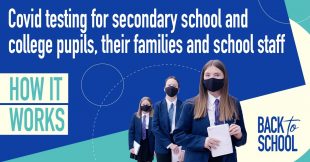
NOTE: This article was updated on 30 March to reflect a change to the guidance around confirmatory PCR tests
All secondary school and college age pupils are eligible for twice weekly testing to help keep covid out of our classrooms as pupils return to education this week. This is how it works.
Who will get tested?
Tests will be available to pupils, students and staff at secondary schools and colleges – so pupils in year 7 and above. Their households and bubbles will also be able to get tested.
Primary school staff, their families and the childcare and support bubbles of pupils also have access to testing. Primary school pupils themselves will not take asymptomatic tests but should book a PCR test online if they develop symptoms.
How will the tests be administered and how often?
This depends on whether you’re a pupil, a member of a pupil’s family or a teacher or member of school staff.
Pupils, teachers and their families should all be tested twice each week.
For pupils, the first three tests will be done on site at schools and colleges under supervision. These will be lateral flow tests which provide a result in approximately 30 minutes. After that, pupils will be given lateral flow device (LFD) testing kits by their school or college to take home.
Upon returning to school or college, teaching and non-teaching staff should take twice-weekly tests using a home test kit provided by their school or college. This includes permanent, temporary and voluntary staff.
If you’re a member of a household, childcare or support bubble of a pupil, student or staff of a school or college, you can get a twice-weekly test:
- through your employer if they offer testing to employees
- at a local asymptomatic test site, managed by your local authority
- by collecting a home test kit from a test site
- by ordering a home test kit online
What happens if a test is positive?
If anyone’s test is positive, they should immediately start isolating in line with public health guidance. Members of their household should also start isolating.
From 30 March, if a member of staff, pupil or student conducts a lateral flow test at home or receives a supervised school/college-based lateral flow test as part of the rapid asymptomatic testing programme, and it is positive then they, their close contacts and other members of their household should self-isolate immediately in line with NHS Test and Trace guidance.
All positive results from rapid tests, whether conducted at home or at a school or college will then need to be confirmed with a PCR test within two days of the positive lateral flow test. Following a positive lateral flow test, a confirmatory PCR test should be booked immediately either online or by calling 119. While awaiting the PCR result, the staff, pupil or student and their close contacts should continue to self-isolate. If the PCR test is negative, it overrides the lateral flow test and the staff, pupil or student can return to school or college.
If a pupil tests positive, does their whole class or year group or other bubble then have to isolate as well?
No. It’s only people who live in the same household as someone with symptoms or who has tested positive or close contacts of people who have tested positive or have symptoms.
Close contacts are:
- People who have had face-to-face contact including being coughed on or having a face-to-face conversation within 1 metre
- People who have been within 1 metre for 1 minute or longer without face-to-face contact
- Sexual contacts
- People who have been within 2 metres of someone for more than 15 minutes (either as a one-off contact, or added up together over one day)
- Travelled in the same vehicle or a plane
For more information about testing for pupils, school staff and their families visit GOV.UK